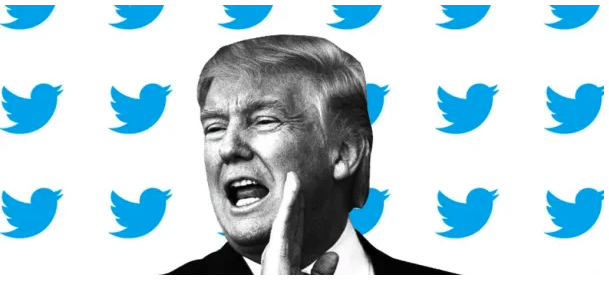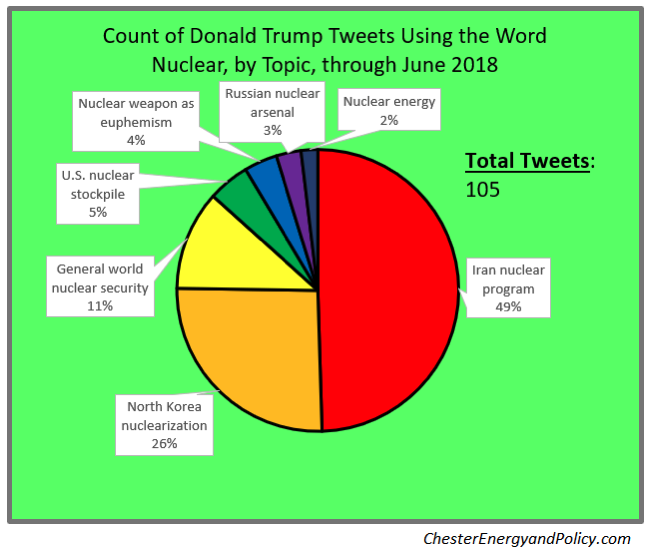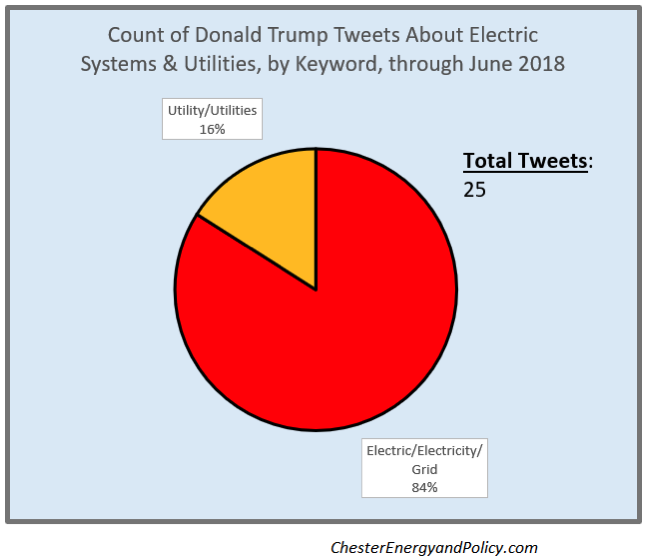War on Coal, Ugly Wind Turbines, and Chinese Climate Hoaxes: The Sad! Story Conveyed Through Nine Years of Trump Tweeting About Energy
Because the Internet is both a terrific and sad place, we have at our fingertips the ability to search through Donald Trump’s entire Twitter history for specific words and phrases. While this tool has been employed to demonstrate that Trump has tweeted more frequently about Rosie O’Donnell than his wife and count the different people he’s called losers, I haven’t seen anyone search through the tens of thousands of tweets to trace out the path of Trump’s publicly expressed opinions on the energy industry. While the major points of Trump’s energy policies are known (coal is beautiful, drill wherever we can, and American wants energy dominance), what else can we learn about how the President feels about various energy technologies and policies by looking at tweets from the days before his political career, while on the campaign trail, and since being elected?
Methodology
Baseline
In any scientific experiment, establishing a control group is important. Similarly, for this analysis, knowing Trump’s rate of Twitter activity over the years is important context. The below graph shows the frequency of all tweets, separated out by quarter, starting from the Donald’s first-ever tweet in May 2009 through the end of the second quarter of 2018 (June 30, 2018).
As this graphic makes evident, Trump’s peak Twitter usage came in the first quarter of 2013 (well before declaring his Presidential candidacy) with 25 tweets per day, dropped a fair amount over the campaign trail, and leveled out at between 5 and 10 tweets per day since taking office.
Categories and keywords
When combing through the archives of Trump tweets for energy-related mentions, the below table highlights the keywords searched within each energy category. The separation based on category and keyword will outline where Trump’s priorities lie for each slice of the energy field (priorities being both positive, like his support of coal, and negative, like his frequent dismissal of wind turbines).
Note: Certain keywords were chosen to be grouped together because of their relation and frequent overlap, like how when Trump tweets about ‘OPEC’ he also frequently uses the word ‘oil’ and vice versa. Also note the right column where I included examples of other energy-related keywords I searched for with no hits, because just as telling as the topics Trump has tweeted about many times are the topics he has never broached. Lastly, just because the keywords were included in a tweet does not mean that the tweet was related to energy. For example, the word ‘oil’ might show up as The Apprentice spoilers and the word ‘energy’ was often used to insult Low-Energy Jeb. To ensure these instances did not tilt the scales, I read through each of the hundreds of tweets to confirm the tweets in question were indeed relevant to energy topics (please consider this an act of public service). I also read each ‘gas’ tweet to determine if they were referencing natural gas or motor gasoline.
Oil and gas industry
Focusing first on the oil and gas industry provides the following view:
Oil and the Organization of the Petroleum Exporting Countries (OPEC) have dominated Trump’s mentions in this category, followed by a focus on gasoline prices. On the other hand, natural gas (the top fuel source in U.S. electricity generation) is seldom mentioned. One potential takeaway from this trend is that oil prices, and specifically their effect on gasoline prices, are among the most impactful, and maybe more importantly, mainstream energy prices that affect both industry and the general public. By focusing his ire on these oil and gasoline prices instead of natural gas, Trump’s message is most easily delivered to his target audience of large corporations and populist circles.
Further down that path, I recall being on vacation (ironically taking my seat at the Hall of Presidents in Disney World) earlier this spring when Trump tweeted about OPEC for the first time as President. Having only personally followed Trump’s tweets since he launched his Presidential campaign, I expected this tweet to be big news on #EnergyTwitter as the first time Trump had mentioned the group. However, looking back at his tweet history, Trump had criticized OPEC 55 different times in his pre-political days, simply remaining silent about the topic on Twitter between 2014 and 2018. The gist of the OPEC tweets is how OPEC is harming the United States when it comes to oil prices and Obama must do something about that. As such, the lesson here is that Trump has a longstanding obsession with how OPEC is ‘winning’ vs. the United States. While Trump has only recently began chastising OPEC on Twitter again, that long-standing grudge bubbling over and turning into official policy intended to ‘beat’ OPEC would not be surprising.
Source: Twitter
Coal
Turning to the coal industry, Trump’s tweets provide the following view:
Because the only word related to the coal industry that Trump has tweeted is ‘coal,’ these tweets have been separated into four subjects: 1) political opponents who Trump says are bad for coal, 2) the state of U.S. coal production, 3) support for coal miners, and 4) the alleged ‘War on Coal.’
Given the fervor with which Trump supported the coal industry on the campaign trail and continues to push measures intended to save the economically-maligned U.S. coal industry, I found the lack of total tweets about the coal sector rather surprising. While oil and gasoline prices affect the general populations, those supporting coal are confined to regions who rely on coal (such as Wyoming and West Virginia) and not the general population (only about 1/3 of Americans oppose the phase-out of coal-fired plants). As such, supporting coal aggressively on Twitter does not benefit Trump the Populist, rather Trump’s publicly-declared support for coal is largely confined to rallies in coal country.
Further, 61% of Trump’s coal-related tweets are focused on coal opponents and the ‘War on Coal,’ while technology like carbon capture and storage/sequestration (CCS) are not mentioned once. Trump hasn’t even sent a single tweet about the several attempts of his administration’s Department of Energy (DOE) to bolster the coal industry through policy means. This trend is further evidence that Trump’s coal rhetoric is more about scoring political points with coal supporters than it is about substantive and technical solutions.
Source: Twitter
Nuclear energy
Trump’s Twitter activity regarding nuclear energy is a bit different. While the below graphic shows that Trump is not shy about tweeting about ‘nuclear,’ those tweets are 98% regarding nuclear weapons rather than nuclear energy.
The two times Trump has ever tweeted anything to do with nuclear energy are copied below:
Neither of these tweets really show what Trump really thinks about nuclear energy, which is a telling fact on its own (though perhaps we don’t have to worry– if you haven’t heard, Trump’s uncle was an MIT professor who used to talk to him about nuclear, so he knows nuclear). While the Trump administration policy pushing to bolster the coal industry has also included incentives for nuclear plants, this lack of Twitter-focus on nuclear energy is further evidence that Trump views nuclear technology predominantly in terms of weapons and the power such weapons can yield, and not the potential energy it can generate (a conclusion supported by his proposed increase in the DOE budget for the nuclear weapons arsenal and decrease in budget for nuclear energy).
Renewable energy
Focusing on renewable energy brings up many Trump tweets, and the tone is decidedly negative:
Trump has only tweeted about three renewable energy technologies ever, though they are the three most prominent renewable sources in the United States. That said, additional U.S. renewable energy sources include biomass, waste fuels, wood, and geothermal energy, which combine for almost 1/5 of U.S. renewable generation. Trump’s historical silence on those topics likely speaks to the lack of priority he puts on exploring additional renewable energy sources.
Focusing on the renewable energy technologies that Trump has tweeted about, the most eye-popping data point from these graphs is that 95% of renewable energy tweets have focused on wind energy. Every single wind-related tweet represented a bashing of the technology, with the below few tweets representative of the lot.
Source: Twitter
As these tweets show, Trump’s attacks are centered on some typical talking points by those fighting the proliferation of wind turbines (they’re ugly, inefficient, and kill birds). But the latter two tweets give more insight into perhaps why Trump was so focused on preventing wind energy– he didn’t want to see turbines from his properties because he thought that would be bad for business and everything else was likely just fill-in rationalization for that goal. Many in the Trump administration say that Trump’s support for fossil fuels does not indicate hostility towards wind energy, especially as offshore wind fits into his ‘America first’ and ‘American Energy Dominance’ pushes. This theory could be supported by Trump’s Twitter-silence on wind energy since declaring he was running for President.
That said, overall Trump’s Twitter archive is not one that paints the picture of a renewable energy advocate. While Trump’s bashing of wind turbines stopped when his political career began, he has only once tweeted support for any renewable energy technology:
Source: Twitter
While building out hydroelectric generation in Scotland is great, the fact that he tweeted about the technology just once and this occurrence came as he was fighting against wind turbines near his Scottish golf property suggests that he was just happy to hear about a local energy source other than wind. All of the other 168 times Trump tweeted about renewable energy (0 of which came after declaring his candidacy for President), the goal was to tear down and dismiss the technology. Trump’s pre-political tweets bashing renewable energy, as well as his silence on renewable energy since, likely reflects a hostility towards the sector and the competition it provides for his preferred oil and coal industries (a conclusion supported by his repeated attempts to massively slash the budget of DOE’s programs related to energy efficiency and renewable energy).
Electricity sector
Analyzing Trump’s tweet history regarding the electricity sector and utilities is also valuable, with the following graphical results:
Of only 25 tweets that fall into this category, all 6 instances mentioning electricity or the grid since becoming President are in reference to the electrical systems of Puerto Rico in the wake of Hurricane Maria– both noting the damage to the systems and pointing out that the Puerto Rican electrical systems were already in poor state before the storms, attempting to justify why federal resources could not continue to be spent restoring power to the island (nine months were required before 99% of the American territory had power restored).
Source: Twitter
Source: Twitter
The goal of these tweets seemed to be to score political points for the job done in responding to the crisis, while also staving off the expected criticism of not continuing to use federal resources to rebuild the island’s grid. Similarly, both mentions of utilities since being President have been to accept credit for reductions in power rates in response to the recently passed tax reform bill:
Source: Twitter
The lesson here is that, unsurprisingly, the only times utilities or the electric grid have been brought up on Twitter by political-era Trump has been to garner political points.This goal is not necessarily an indictment of Trump, as the same can likely be said for any politician on social media, so what about the 68% of Trump’s tweets in this category that came before he was President?
The notable pre-political tweets include: two tweets admonishing Florida Power & LIght as an awful utility, four tweets lamenting rising electrical prices, three tweets dismissing wind turbines, three tweets bashing federal investment in electric vehicles, and three tweets criticizing the federal response to power blackouts in New York and New Jersey after Hurricane Sandy. While lessons can be gleaned in each of these categories, the last one deserves unpacking.
Source: Twitter
Comparing these tweets with the previous tweets on Puerto Rico’s power outages is quite the juxtaposition, as two weeks after Hurricane Maria only 9% of Puerto Rico had their power restored. I’ll leave it to the reader to hypothesize why Trump expressed one opinion about the New York/New Jersey blackouts and another about the blackouts in Puerto Rico. The lesson I’ll propose, though, is that Trump publicly holds himself to different standards than other politicians and his predecessors when it comes to disaster response and restoring electrical systems.
Energy
Investigating tweets using the word energy looks like the following:
These tweets can be separated into the four main categories: 1) negative comments about renewable energy, 2) comments on the international energy markets, 3) comments on energy prices, energy dependence, or energy jobs (most of these tweets incorporate two or three of these concepts, so they are grouped together), and 4) extolling American energy (specifically boasting about America’s reserves of oil, gas, and coal).
What becomes evident in these graphs is Trump’s focus on bashing renewable energy was purely from his pre-political Twitter days, while focusing on American energy and the benefits those reserves could provide for U.S. energy prices and jobs is a long-held belief he took from his pre-political days into the Oval Office.
Environmental issues
Donald Trump has never, neither as a real estate mogul/reality TV star nor as President, labeled himself an environmentalist. Rather, one of his more infamous pre-political tweets was his assertion that global warming was a hoax invented by the Chinese to gain an edge over American industry. As such, his tweets on these issues can hardly be surprising:
Among his environment-related tweets, climate change is the most frequent focus. In his pre-political days, Trump took joy in pointing to cold and snowy days as evidence against climate change. For the most part, political advisers appear to have put a stop to these tweets once he entered the race for the White House. Only once as a candidate did he make similar suggestions, and as President, the first five climate-related tweets were Trump singing his own praises for decommitting the United States from the Paris Climate Accord. However, by the end of 2017 President Trump couldn’t help himself and again erroneously tried to connect a cold winter day to evidence that climate change isn’t real.
Source: Twitter
Through his tweets, Trump has long established a position that is anti-science and against the findings of human-caused climate change with which over 97% of scientists agree. The dramatic drop-off in tweets questioning climate change could be due to his advisors, either trying to get him to accept the reality of climate change or just pointing out the political damage of being a public climate denier amidst a record amount of the population accepting that the climate is changing due to human activity (including 50% of Republicans). However, Trump’s pointing to cold weather as evidence against climate change, both as a candidate and as President, serve to prove that these advisors have not served to change his mind. These tweets support the fact that Trump’s withdrawing from Paris Accord was not just because of claims the deal was unfair to the United States, rather this action is rooted in Trump’s long-held refusal to understand and address climate change.
Further, Trump’s non-climate tweets in the environmental category are all either:
Claiming wind energy destroys the environment (16 tweets);
Complaining that environmental regulations are unnecessary and unfair (7 tweets);
Ripping the Obama administration for ‘wasting money’ on green energy technologies (5 tweets);
Criticizing China for how much they pollute the environment (3 tweets);
Claiming oil and gas pipelines are a net positive for the environment (2 tweets); and
Mocking environmentalism and its supporters as crazy (2 tweets).
The takeaway from Trump’s tweets here is that he only claims to care about the environment when doing so behooves his already established interests (e.g., anti-wind, pro-pipeline, anti-Obama, anti-China), and he appears to look down upon those who are truly invested in protecting the environment.
Overall conclusions
Pulling back out to look at all the categories of energy-related tweets provides the following views:
It bears repeating, if you put me in a time machine back to the beginning of 2015 and showed me the top graph that the future President would tweet about renewable energy and environmental issues that much, I probably would have been ecstatic. Even the CEO of Shell, the world’s largest oil company, recognizes the need for a clean energy transition,calling for non-electric cars to be banned in the United Kingdom sooner than is plannedand stewarding the company to invest up to $2 billion per year in renewables and clean fuel technology. But the fact that Trump, as President, has never once endorsed renewable energy technology and actively fights the science behind climate change is frightening. Even if you’re of the opinion that peak oil is yet to be reached or that coal is critical to the baseload energy supply, to never admit any of the positives of renewable energy is willful ignorance.
Rather, Trump’s historical Twitter usage elucidates just how much his public positions reflect his attempts to play to a populist base who might suffer from increased energy prices, support his own business interests in fighting wind energy and disparaging OPEC, and say whatever he can to score political points through fervently supporting coal at rallies but not on Twitter and deflecting blame for Puerto Rico’s blackouts.
Are there any potential conclusions to draw from this data that I may be missing? Or do you disagree with my takeaways? Please let me know in the comments below or on Twitter.




























